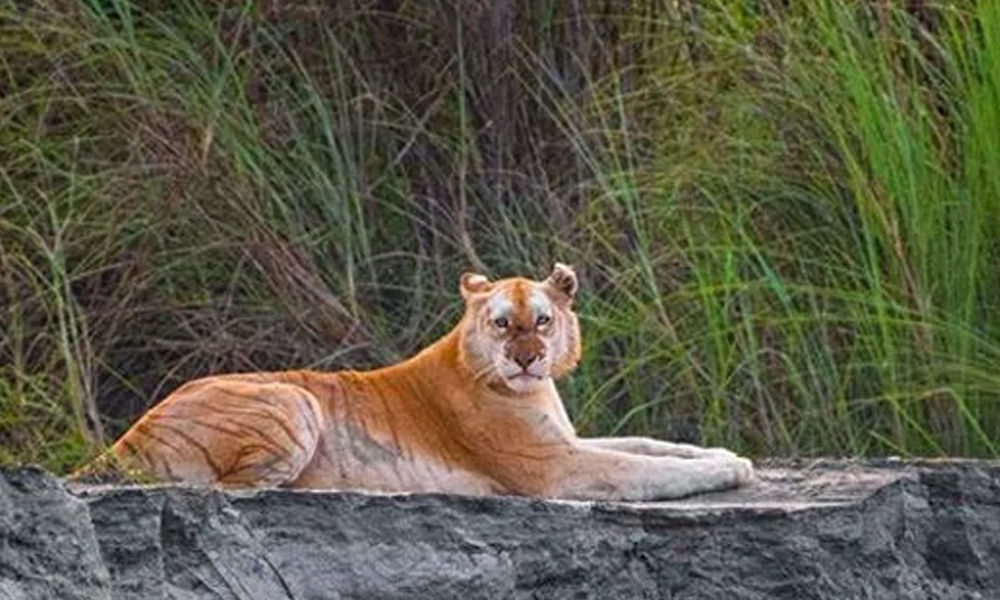Ever since Indian Forest Service officer Parveen Kaswan shared the photo of a golden tiger at Assam’s Kaziranga National Park and Tiger Reserve early this week, the image has gone viral on social media, leaving many in awe.
The image, clicked by wildlife photographer Mayuresh Hendre, shows a female tiger with rare golden-hued fur. ‘Do you know in India we have a Golden Tiger also. Only documentation of such big cat in 21st century on planet. This by Mayuresh Hendre. Look at this beauty,’ Kaswan had said while sharing the image of the big cat on Twitter on July 11.
Do you know in #India we have a Golden #Tiger also. Only documentation of such big cat in 21st century on planet. This by Mayuresh Hendre. Look at this beauty. pic.twitter.com/8kiOy5fZQI
— Parveen Kaswan, IFS (@ParveenKaswan) July 10, 2020
‘They are very rare and some say it is caused by a recessive gene that gets expressed due to extensive inbreeding. Few were recorded in zoo. But rarely captured in wild. And in recent years this one individual. Same was captured in a camera trap of FD few years back and shared in public by authorities. She is a female,’ he added in a series of tweets.
Dr Firoz Ahmed, the head of Tiger Research and Conservation Division at NGO Aaryanak, told PTI that the big cat, first spotted in 2014 during an all India tiger monitoring exercise, has ‘lighter yellowish skin tone, narrower black stripes, whiter abdominal and facial regions when compared to a normal Royal Bengal Tiger.’
According to experts, the golden tigress has a ‘colour aberration caused by a unique gene.’
Since being shared, the image has gained over 17,000 likes and over 2,300 retweets. While the rare big cat continues to create a buzz on social media, park experts say that her golden colour is no cause for celebration.
According to a report by Rabindra Sharma, wildlife expert and research officer at Kaziranga Tiger Reserve, the golden tigress of Kaziranga – known as Kazi 106-F – gets her colouring from recessive genes that are a result of inbreeding caused by habitat loss.
‘However, the finding of this unique individual is not a cause for celebration, but an indication for us to start pondering about better connectivity among fragmented populations of tigers to prevent one of the serious problems of population decline i.e. inbreeding,’ Sharma wrote in research. The report was shared by Kaziranga National Park and Tiger Reserve on Twitter, early this week.
‘Kaziranga needs connectivity with other forested area, specially unhindered connectivity with Karbi Anglong,’ he added.
The park said that four such tigers are there in Kaziranga. ‘GOLDEN TIGER OF KAZIRANGA – A Social Media Star. She is KAZI 106-F, a rare phenomenon in wild. ‘NOT ONE BUT FOUR ‘ such tigers with color aberration exist in Kaziranga Tiger Teserve,’ it said.
GOLDEN TIGER OF KAZIRANGA – A Social Media StarShe is KAZI 106-F, a rare phenomenon in wild. ‘NOT ONE BUT FOUR ‘ such tigers with color aberration exist in Kaziranga Tiger TeserveAn article about them @CMOfficeAssam @ParimalSuklaba1 @RandeepHooda @surenmehra @ParveenKaswan pic.twitter.com/K72CthKI2s
— Kaziranga National Park & Tiger Reserve (@kaziranga_) July 14, 2020
In the report, Rabindra Sharma said that colour aberrations are not very common andonly a few are recorded in the wild.
‘The biological reason of colour aberration may be due to excessive inbreeding caused by habitat destruction and loss of connectivity. The recessive genes are showing up due to inbreeding within a fragmented population,’ the report said.
It also pointed out that a recent study by Cardiff University and National Center for Biological Sciences(NCBS) found that 93% of the tiger DNA variants from British period are no longer present in the current tiger population.
The yellowish background is controlled by a set of ‘agouti genes’ and their alleles and the black colour stripes are controlled by ‘tabby genes’ and their alleles. Suppression of any of these genes may lead to colour variation in the tiger.
‘Agouti genes interacts with the pigment cells to produce yellow to red or brown to black expression. This interaction is responsible for making distinct light and dark bands in the hairs of animals such as the agouti. In other species such as horses, it determines what parts of the body are red or black. Here same is happening in our tigress – Kazi 106 F,’ the report said.
The tigress was first captured on camera in Kaziranga in 2014. She was captured on camera in 2015 as well and in 2016, she was photographed with another tiger. However, it could not be concluded whether the other tiger was her cub or mate due to the low quality of the image, the report said.
According to Sharma, the tigers found in Kaziranga are different from those found elsewhere in territorial behavioural pattern, making a detailed study on them even more interesting and challenging.
‘I think the inbreeding is by choice and not driven by compulsion as there are 15 female and 13 male in the group of Kazi…











